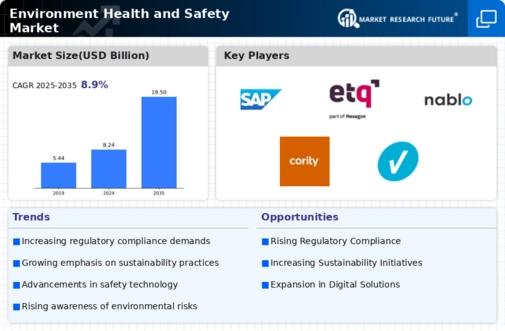Top Industry Leaders in the Environment Health Safety Market
Competitive Landscape of the Environment, Health, and Safety (EHS) Market
The Environment, Health, and Safety (EHS) market is a dynamic and growing sector driven by a confluence of factors like stricter regulations, rising awareness, and technological advancements. This analysis delves into the competitive landscape, highlighting key players, strategies, market share analysis factors, emerging companies, and current investment trends.
Key Players:
- EHS are – SAP (Germany)
- EtQ (US)
- Gensuite (US)
- Enablon (US)
- Intelex (Canada)
- Enviance (US)
- Verisk 3E (US)
- Sphera Solutions (US)
- Cority (Canada)
- VelocityEHS (US)
- Among Others
Key Strategies:
- Global Giants: Environmental Resource Management (ERM), SAP SE, Intelex Technologies, and Cority (formerly Medgate) hold significant market share. They leverage established brands, extensive service portfolios encompassing software, consulting, and training, and global reach to cater to diverse client needs. Their strategies hinge on continuous product innovation, strategic acquisitions, and partnerships with technology companies.
- Regional Specialists: AECOM, CH2M, and Tetra Tech are prominent regional players with strong footholds in engineering and construction sectors. They capitalize on deep industry knowledge, specialized solutions for specific EHS challenges, and established relationships with local regulators and stakeholders. Their focus on expanding service offerings and building strategic alliances with technology vendors is key to their competitive edge.
- Technology Disruptors: VelocityEHS, Enablon, and IHS Markit are revolutionizing the market with cloud-based EHS platforms, artificial intelligence (AI), and data analytics. They offer cost-effective, scalable solutions, and real-time insights, attracting budget-conscious clients and those seeking data-driven decision-making. Their rapid innovation and agile development cycles are crucial differentiators.
Market Share Analysis:
Factors influencing market share analysis include:
- Product Portfolio Breadth: Diversified offerings cater to various industry segments and EHS needs, solidifying market presence.
- Geographic Reach: Global presence allows for tapping into diverse markets and client segments.
- Technology Innovation: Continuous development of AI-powered solutions and data analytics tools enhances competitiveness.
- Customer Service and Support: Responsive and efficient customer service builds trust and loyalty, leading to repeat business.
- Regulatory Expertise: Deep understanding of evolving regulations and compliance requirements assures clients of their legal and operational safety.
Emerging Players and Trends:
The EHS market welcomes new entrants capitalizing on niche segments and technological advancements.
- Sustainability-focused Startups: Companies like EcoVadis and Sustainalytics offer sustainability-as-a-service solutions, integrating environmental and social factors into EHS management.
- IoT and Wearables Developers: Companies like Sensative and BioIntelli are leveraging wearable technology for real-time employee safety monitoring and risk prediction.
- Blockchain-powered Solutions: Startups like Everledger and VeChain are exploring blockchain's potential for secure data management and supply chain transparency in EHS applications.
Current Investment Trends:
- Cloud-based EHS Software: Companies are investing heavily in cloud-based platforms offering scalability, accessibility, and cost-effectiveness.
- AI and Machine Learning (ML) Integration: AI-powered solutions for risk prediction, incident analysis, and predictive maintenance are gaining traction.
- Data Analytics and Reporting: Advanced data analytics tools are enabling organizations to gain deeper insights into EHS performance and optimize strategies.
- Talent Acquisition and Development: The need for skilled EHS professionals proficient in new technologies is driving investments in talent acquisition and training programs.
Latest Company Updates:
In 2023, Pactiv Evergreen Inc. published 'Packaging a Better Future,' its most recent Environmental, Social, and Governance ("ESG") Report, which detailed the company's progress towards its lofty targets for 2021 and 2022. Progress has been made in all three of the company's strategic ESG pillars: value our people and communities, deliver sustainable products that are essential to consumers, and protect our planet's resources. These pillars are underpinned by robust ESG governance practises.
In 2022, a UN Environment Programme (UNEP) report offers fresh perspectives on steps that relevant parties should take to reduce the harmful effects of fertilisers and pesticides on the environment and human health. The UN Food and Agriculture Organisation (FAO) was closely consulted in the writing of the report, Environmental and Health Impacts of Pesticides and Fertilisers and Ways to Minimise Them.

